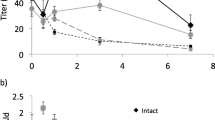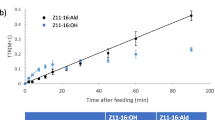Abstract
Sensory hair proteins from antennae of males of the wild silk moth,Antheraea polyphemus (Lepidoptera, Saturniidae) were incubated with radiolabeled 6E,11Z-hexadecadienyl acetate in the presence of unlabeled pheromone analogs as competitive inhibitors. The two extracellular proteins of importance, a highly active sensillar esterase and an abundant 15,000 mol wt binding protein, interact to degrade labeled pheromone less efficiently in the presence of certain unsaturated acetate analogs of the natural pheromone.
Enzymatic hydrolysis of the acetate (or diazoacetate) was also examined for three pheromone analogs: [11,12-3H2]-6E,11Z-hexadecadienyl diazoacetate, [11,12-3H2]-hexadecyl acetate, and [9,10-3H2]-9Z-tetradecenyl acetate. The former two are poor substrates at concentrations over four orders of magnitude. The 9Z–14:Ac, however, is the best alternative substrate for this in vitro pheromone metabolism system. Unlabeled 9Z–14: Ac is also the best competitive inhibitor of the hydrolysis of labeled 6E, 11Z–16: Ac. Whereas the tritiated natural pheromone shows a flat response (ca. 40% conversion) to increasing concentrations from 3 × 10−9 to 3 × 10−6 M, tritiated 9Z–14: Ac is degraded more rapidly at higher concentrations.
Similar content being viewed by others
References
Boeckh, J., andBoeckh, V. 1979. Threshold and odor specificity of pheromone-sensitive neurons in the deutocerebrum ofAntheraea pernyi andA. polyphemus (Saturnidae).J. Comp. Physiol. 132:235–242.
Ferkovich, S.M. 1981. Enzymatic alteration of insect pheromones, pp. 165–186,in D.M. Noms (ed.). Perception of Behavioral Chemicals. Elsevier/North Holland, Amsterdam.
Ganjian, I., Pettei, M., Nakanishi, K., andKaissling, K.-E. 1978. A photoaffinity-labeled insect sex pheromone for the mothAntheraea polyphemus.Nature 271:157–158.
Henrick, C.A. 1977. The synthesis of insect sex pheromones.Tetrahedron 34:1845–1889.
Kaissling, K.E., Klein, U., de Kramer, J.J., Keil, T.A., Kanauija, S., andHemberger, J. 1985. Insect olfactory cells: Electrophysiological and biochemical studies, pp. 1–11,in J.P. Changeux, F. Hucho, A. Maelicke, and E. Neumann, (eds.). Molecular Basis of Nerve Activity: Proceedings of the International Symposium W. de Gruyter, Berlin.
Klein, U. andKeil, T.A. 1984. Dendritic membrane from insect olfactory hairs: Isolation method and electron microscopical observations.Cell. Molec. Neurobiol. 4:385–396.
Kochansky, J., Tette, J., Taschenberg, E.F., Cardé, R.T., Kaissling, K.-E., andRoelofs, W.L. 1975. Sex pheromone of the mothAntheraea polyphemus.J. Insect Physiol. 21:1977–1983.
Prestwich, G.D., Golec, F.A., andAndersen, N.H. 1984a. Synthesis of a highly tritiated photoaffinity labeled pheromone analog for the mothAntheraea polyphemus.J. Labelled Compd. Radiopharmacol. 21:593–601.
Prestwich, G.D., Singh, A.K., Carvalho, J.F., Koeppe, J.K., Kovalick, G.E., andChang, E. 1984b. Photoaffinity labels for insect juvenile hormone binding proteins.Tetrahedron 40:529–537.
Priesner, E., Jacobson, M., andBestman, H.J. 1975. Structure-response relationships in noctuid sex pheromone reception.Z. Naturforsch. 30c:283–293.
Still, W.C., Kahn, M., andMitra, A. 1978. Rapid chromatographic technique for preparative separations with moderate resolution.J. Org. Chem. 43:2923–2925.
Vogt, R.G. 1984. The biochemical design of sex pheromone reception in the wild silk mothAntheraea polyphemus. PhD thesis. University of Washington (University Microfilms, 300 North Zeeb Road, Ann Arbor, Michigan 48106).
Vogt, R.G., andRiddiford, L.M. 1981. Pheromone binding and inactivation by moth antennae.Nature 193:161–163.
Vogt, R.G., andRiddiford, L.M. 1986. Pheromone reception: A kinetic equilibrium, pp. 201–208,in (T. Payne, R. Cardé, and J. Boeckh (eds.). Mechanisms of Perception and Orientation to Insect Olfactory Signals. Oxford University Press, Oxford. In press.
Vogt, R.G., Riddiford, L.M., andPrestwich, G.D. 1985. Kinetic properties of a pheromone degrading enzyme: The sensillar esterase ofAntheraea polyphemus.Proc. Natl. Acad. Sci. U.S.A. 82:8827–8831.
Vogt, R.G.,Prestwich, G.D., andRiddiford, L.M. 1986. Photoaffinity labeling of soluble and membrane proteins of isolated pheromone-specific sensory hairs of the mothAntheraea polyphemus. In preparation.
Author information
Authors and Affiliations
Additional information
Fellow of the Alfred P. Sloan Foundation (1981–1985) and Camille and Henry Dreyfus Teacher-Scholar (1981–1986).
Rights and permissions
About this article
Cite this article
Prestwich, G.D., Vogt, R.G. & Riddiford, L.M. Binding and hydrolysis of radiolabeled pheromone and several analogs by male-specific antennal proteins of the mothAntheraea polyphemus . J Chem Ecol 12, 323–333 (1986). https://doi.org/10.1007/BF01020559
Received:
Accepted:
Issue Date:
DOI: https://doi.org/10.1007/BF01020559




